Critical Analysis: Qualitative Research & Evidence-Based Healthcare
VerifiedAdded on 2023/06/11
|22
|2518
|212
Report
AI Summary
This report critically debates the role of qualitative research in healthcare practice in relation to evidence-based medicine (EBM), randomized controlled trials (RCTs), systematic reviews, and Quality-Adjusted Life Years (QALYs). It defines EBM and differentiates between qualitative and quantitative research, emphasizing the importance of EBM in updating healthcare professionals' knowledge and providing access to relevant data for improving patient care. The discussion on RCTs highlights their significance in medical trials for minimizing bias through randomization and blinding techniques, alongside addressing potential biases like selection, performance, and reporting bias. The report also elucidates the steps involved in conducting a systematic review, from formulating questions to interpreting findings, and concludes by examining QALYs as a measure of disease burden and health outcomes in healthcare economic evaluations. The document concludes with a brief overview of diagnostic tests in healthcare.

EVIDENCE BASED
PRACTICES
PRACTICES
Paraphrase This Document
Need a fresh take? Get an instant paraphrase of this document with our AI Paraphraser

Critically debate the role of Qualitative research in healthcare practice in relation
to the topics covered in the module?
What is EBM?
Evidence-based Medicine (EBM) is a kind of evidence which is by the health care
professionals in order to make important decisions with respect to the health and caring of a
specific patient.
It is a practice used by the heath care professionals which aims to enhance the quality of
research under the healthcare sector in order to make clinical decisions. The EBM makes use
of new skills within the health care professionals or clinicians which involves the use of
effective methods for the purpose of extracting essential literature and implementing certain
rules and regulation in order to examine the relevant clinical literature.
Qualitative vs quantitative
There are basically two methods of carrying out a research, they are, namely, qualitative
research and quantitative research.
Qualitative research can be described as research on the basis of information which is not in
the form of numbers. It includes information which is based on the experience of an
individual or any other group of people for the purpose of determining the facts and relevant
information in relation to a specific subject.
On the other hand, the quantitative research can be defined as a research which involves the
information in the form of numbers in order to formulate the conclusions of research.
to the topics covered in the module?
What is EBM?
Evidence-based Medicine (EBM) is a kind of evidence which is by the health care
professionals in order to make important decisions with respect to the health and caring of a
specific patient.
It is a practice used by the heath care professionals which aims to enhance the quality of
research under the healthcare sector in order to make clinical decisions. The EBM makes use
of new skills within the health care professionals or clinicians which involves the use of
effective methods for the purpose of extracting essential literature and implementing certain
rules and regulation in order to examine the relevant clinical literature.
Qualitative vs quantitative
There are basically two methods of carrying out a research, they are, namely, qualitative
research and quantitative research.
Qualitative research can be described as research on the basis of information which is not in
the form of numbers. It includes information which is based on the experience of an
individual or any other group of people for the purpose of determining the facts and relevant
information in relation to a specific subject.
On the other hand, the quantitative research can be defined as a research which involves the
information in the form of numbers in order to formulate the conclusions of research.
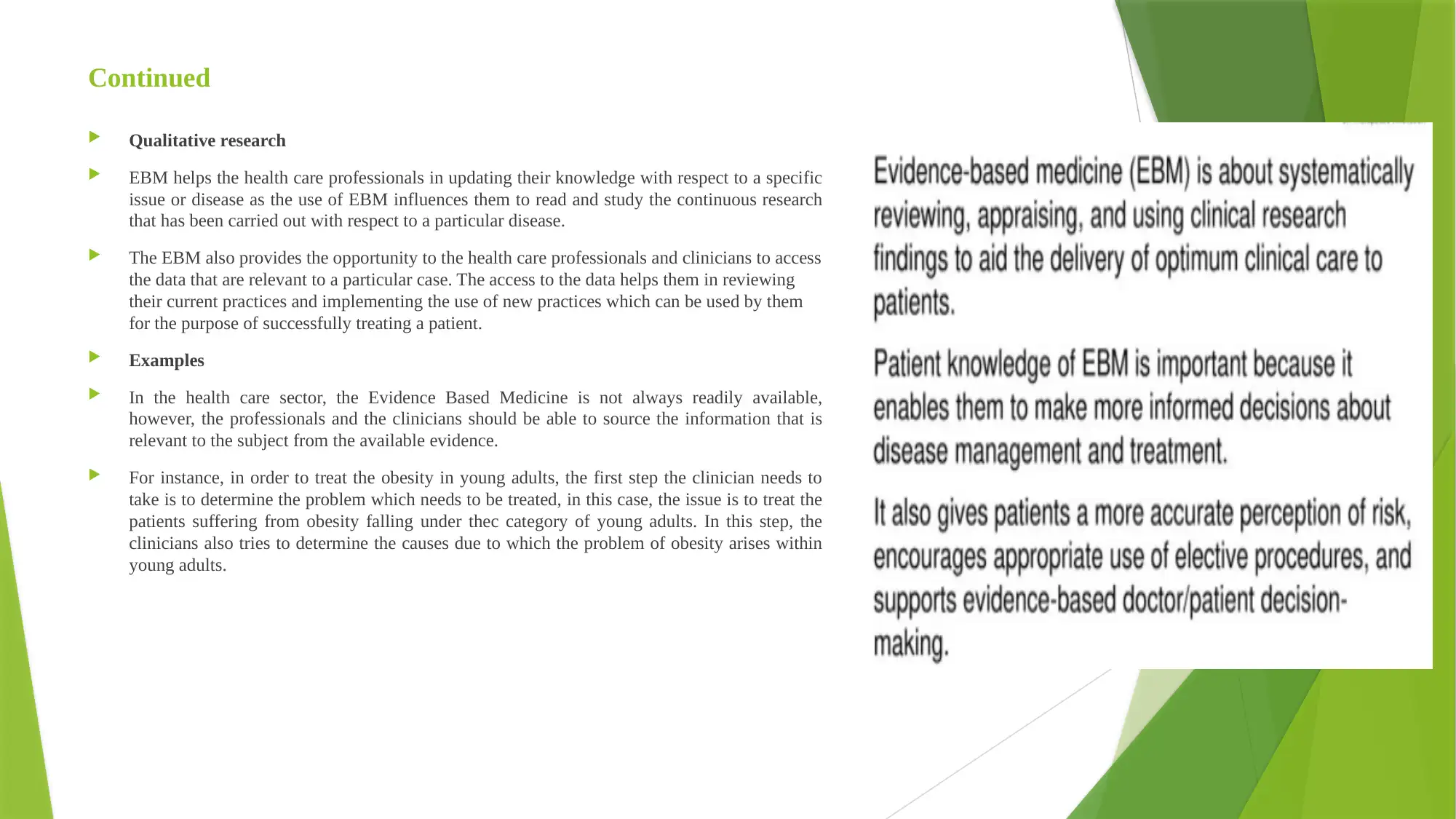
Continued
Qualitative research
EBM helps the health care professionals in updating their knowledge with respect to a specific
issue or disease as the use of EBM influences them to read and study the continuous research
that has been carried out with respect to a particular disease.
The EBM also provides the opportunity to the health care professionals and clinicians to access
the data that are relevant to a particular case. The access to the data helps them in reviewing
their current practices and implementing the use of new practices which can be used by them
for the purpose of successfully treating a patient.
Examples
In the health care sector, the Evidence Based Medicine is not always readily available,
however, the professionals and the clinicians should be able to source the information that is
relevant to the subject from the available evidence.
For instance, in order to treat the obesity in young adults, the first step the clinician needs to
take is to determine the problem which needs to be treated, in this case, the issue is to treat the
patients suffering from obesity falling under thec category of young adults. In this step, the
clinicians also tries to determine the causes due to which the problem of obesity arises within
young adults.
Qualitative research
EBM helps the health care professionals in updating their knowledge with respect to a specific
issue or disease as the use of EBM influences them to read and study the continuous research
that has been carried out with respect to a particular disease.
The EBM also provides the opportunity to the health care professionals and clinicians to access
the data that are relevant to a particular case. The access to the data helps them in reviewing
their current practices and implementing the use of new practices which can be used by them
for the purpose of successfully treating a patient.
Examples
In the health care sector, the Evidence Based Medicine is not always readily available,
however, the professionals and the clinicians should be able to source the information that is
relevant to the subject from the available evidence.
For instance, in order to treat the obesity in young adults, the first step the clinician needs to
take is to determine the problem which needs to be treated, in this case, the issue is to treat the
patients suffering from obesity falling under thec category of young adults. In this step, the
clinicians also tries to determine the causes due to which the problem of obesity arises within
young adults.
⊘ This is a preview!⊘
Do you want full access?
Subscribe today to unlock all pages.

Trusted by 1+ million students worldwide

Continued
Evaluation and conclusion
On the basis of the above findings, it can be stated that the implementation of
the EBM within the health care sector, helps the workforce within the
hospitals to increase their efficiency and improve their quality of the service
provided.
The evidence which are determined using the qualitative research helps the
health care professionals in reviewing their practices and taking steps in order
to update the practices in use for the purpose of enhancing the experience of
the patient and conducting its treatment successfully.
The implementation of the EBM within the health care sector helps them in
increasing the knowledge base of the clinicians and health care professional
with regard to the treatment of individuals
Evaluation and conclusion
On the basis of the above findings, it can be stated that the implementation of
the EBM within the health care sector, helps the workforce within the
hospitals to increase their efficiency and improve their quality of the service
provided.
The evidence which are determined using the qualitative research helps the
health care professionals in reviewing their practices and taking steps in order
to update the practices in use for the purpose of enhancing the experience of
the patient and conducting its treatment successfully.
The implementation of the EBM within the health care sector helps them in
increasing the knowledge base of the clinicians and health care professional
with regard to the treatment of individuals
Paraphrase This Document
Need a fresh take? Get an instant paraphrase of this document with our AI Paraphraser
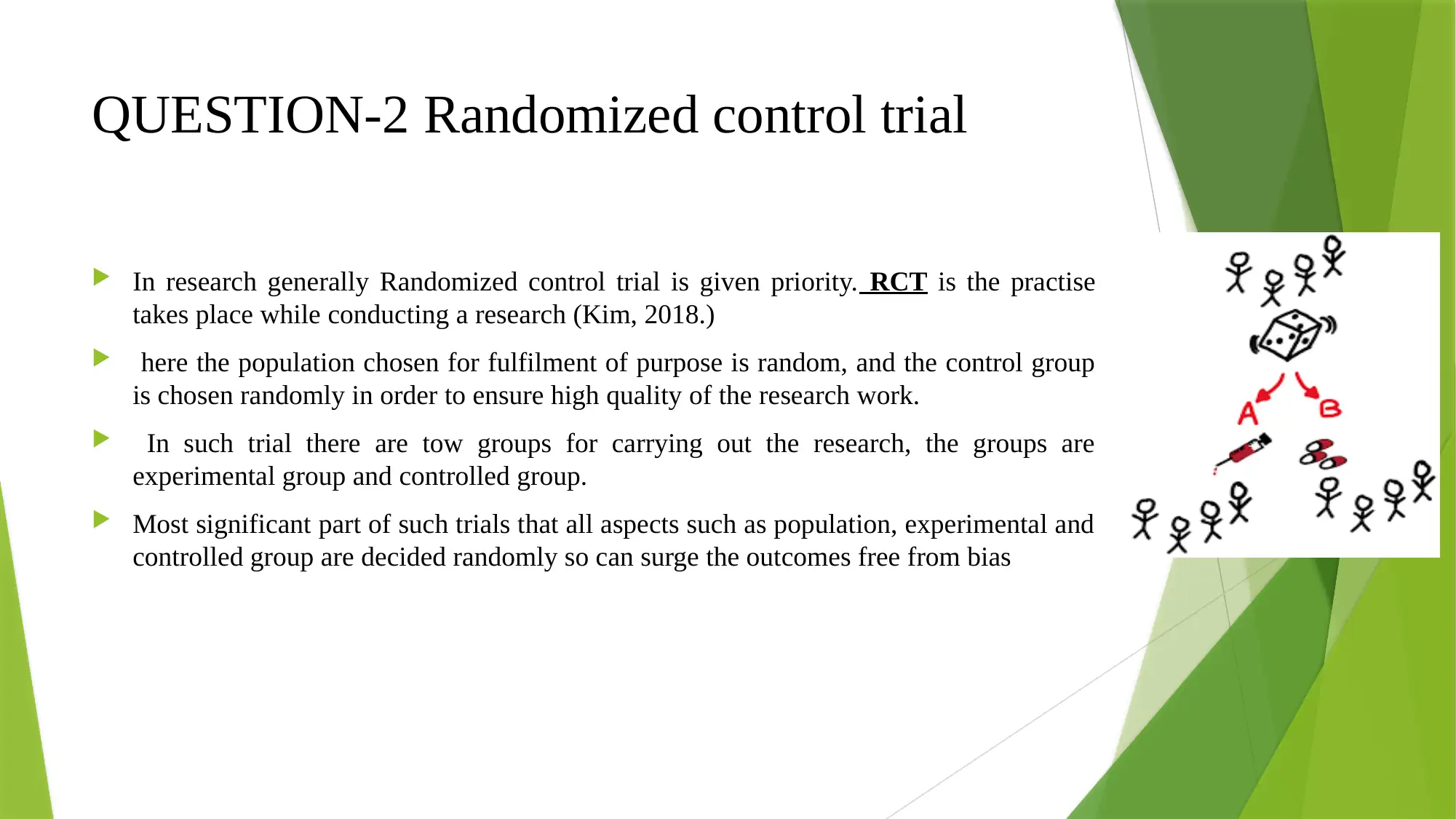
QUESTION-2 Randomized control trial
In research generally Randomized control trial is given priority. RCT is the practise
takes place while conducting a research (Kim, 2018.)
here the population chosen for fulfilment of purpose is random, and the control group
is chosen randomly in order to ensure high quality of the research work.
In such trial there are tow groups for carrying out the research, the groups are
experimental group and controlled group.
Most significant part of such trials that all aspects such as population, experimental and
controlled group are decided randomly so can surge the outcomes free from bias
In research generally Randomized control trial is given priority. RCT is the practise
takes place while conducting a research (Kim, 2018.)
here the population chosen for fulfilment of purpose is random, and the control group
is chosen randomly in order to ensure high quality of the research work.
In such trial there are tow groups for carrying out the research, the groups are
experimental group and controlled group.
Most significant part of such trials that all aspects such as population, experimental and
controlled group are decided randomly so can surge the outcomes free from bias
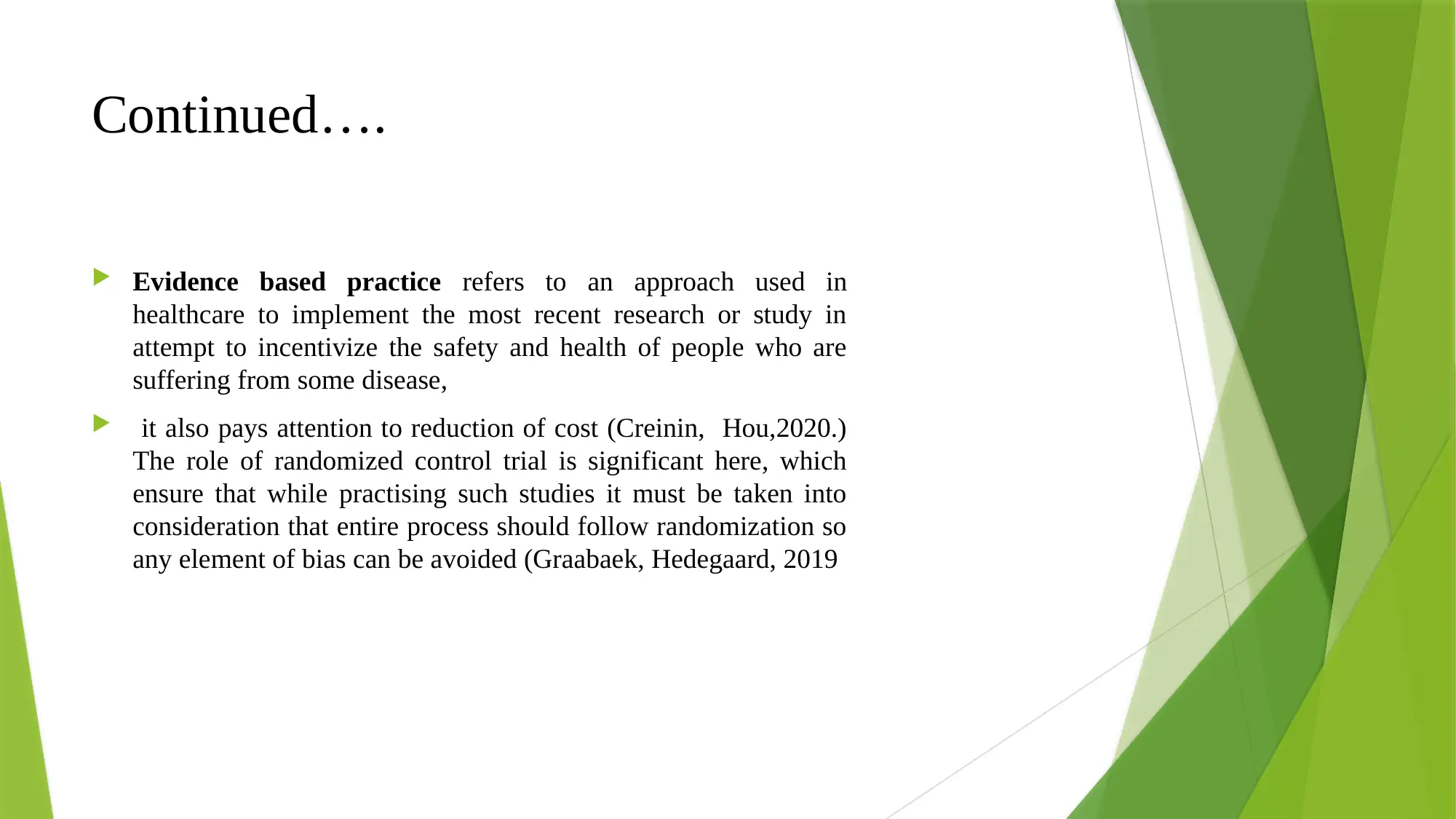
Continued….
Evidence based practice refers to an approach used in
healthcare to implement the most recent research or study in
attempt to incentivize the safety and health of people who are
suffering from some disease,
it also pays attention to reduction of cost (Creinin, Hou,2020.)
The role of randomized control trial is significant here, which
ensure that while practising such studies it must be taken into
consideration that entire process should follow randomization so
any element of bias can be avoided (Graabaek, Hedegaard, 2019
Evidence based practice refers to an approach used in
healthcare to implement the most recent research or study in
attempt to incentivize the safety and health of people who are
suffering from some disease,
it also pays attention to reduction of cost (Creinin, Hou,2020.)
The role of randomized control trial is significant here, which
ensure that while practising such studies it must be taken into
consideration that entire process should follow randomization so
any element of bias can be avoided (Graabaek, Hedegaard, 2019
⊘ This is a preview!⊘
Do you want full access?
Subscribe today to unlock all pages.

Trusted by 1+ million students worldwide

Continued….
People who participate in such trials are known as “Subject” and all needed
interventions are implemented on them by selecting controlled group on random basis.
The interventions are implemented on tow or may be more groups, and then the results
are compared in attempt to finalize the outcomes of trials (Hoysted, Jobson and Alisic,
2019)
In other words RCT is the form of trials which is quantitative in nature and elements as
comparative, prospective, are considered.
People who participate in such trials are known as “Subject” and all needed
interventions are implemented on them by selecting controlled group on random basis.
The interventions are implemented on tow or may be more groups, and then the results
are compared in attempt to finalize the outcomes of trials (Hoysted, Jobson and Alisic,
2019)
In other words RCT is the form of trials which is quantitative in nature and elements as
comparative, prospective, are considered.
Paraphrase This Document
Need a fresh take? Get an instant paraphrase of this document with our AI Paraphraser
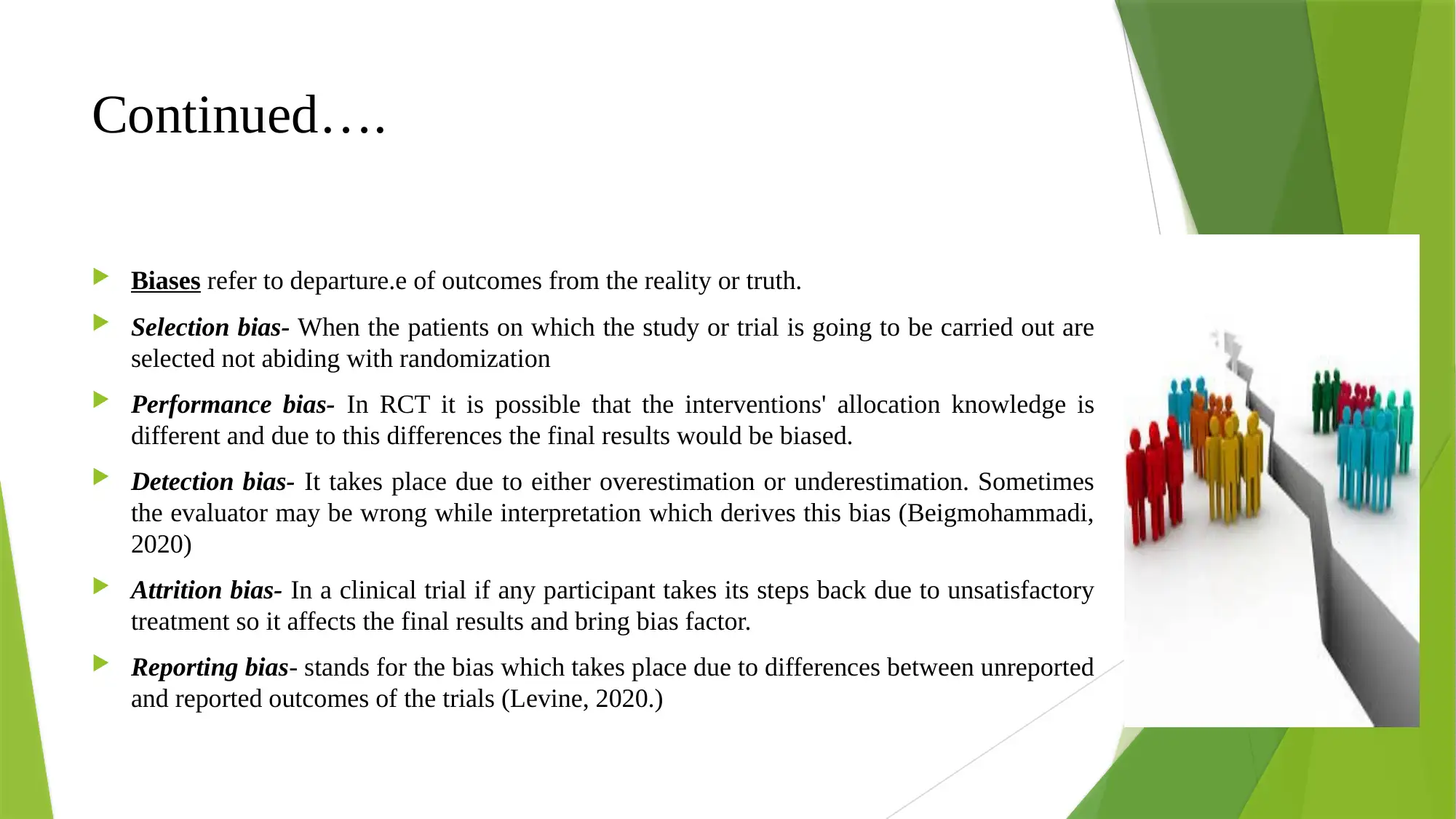
Continued….
Biases refer to departure.e of outcomes from the reality or truth.
Selection bias- When the patients on which the study or trial is going to be carried out are
selected not abiding with randomization
Performance bias- In RCT it is possible that the interventions' allocation knowledge is
different and due to this differences the final results would be biased.
Detection bias- It takes place due to either overestimation or underestimation. Sometimes
the evaluator may be wrong while interpretation which derives this bias (Beigmohammadi,
2020)
Attrition bias- In a clinical trial if any participant takes its steps back due to unsatisfactory
treatment so it affects the final results and bring bias factor.
Reporting bias- stands for the bias which takes place due to differences between unreported
and reported outcomes of the trials (Levine, 2020.)
Biases refer to departure.e of outcomes from the reality or truth.
Selection bias- When the patients on which the study or trial is going to be carried out are
selected not abiding with randomization
Performance bias- In RCT it is possible that the interventions' allocation knowledge is
different and due to this differences the final results would be biased.
Detection bias- It takes place due to either overestimation or underestimation. Sometimes
the evaluator may be wrong while interpretation which derives this bias (Beigmohammadi,
2020)
Attrition bias- In a clinical trial if any participant takes its steps back due to unsatisfactory
treatment so it affects the final results and bring bias factor.
Reporting bias- stands for the bias which takes place due to differences between unreported
and reported outcomes of the trials (Levine, 2020.)
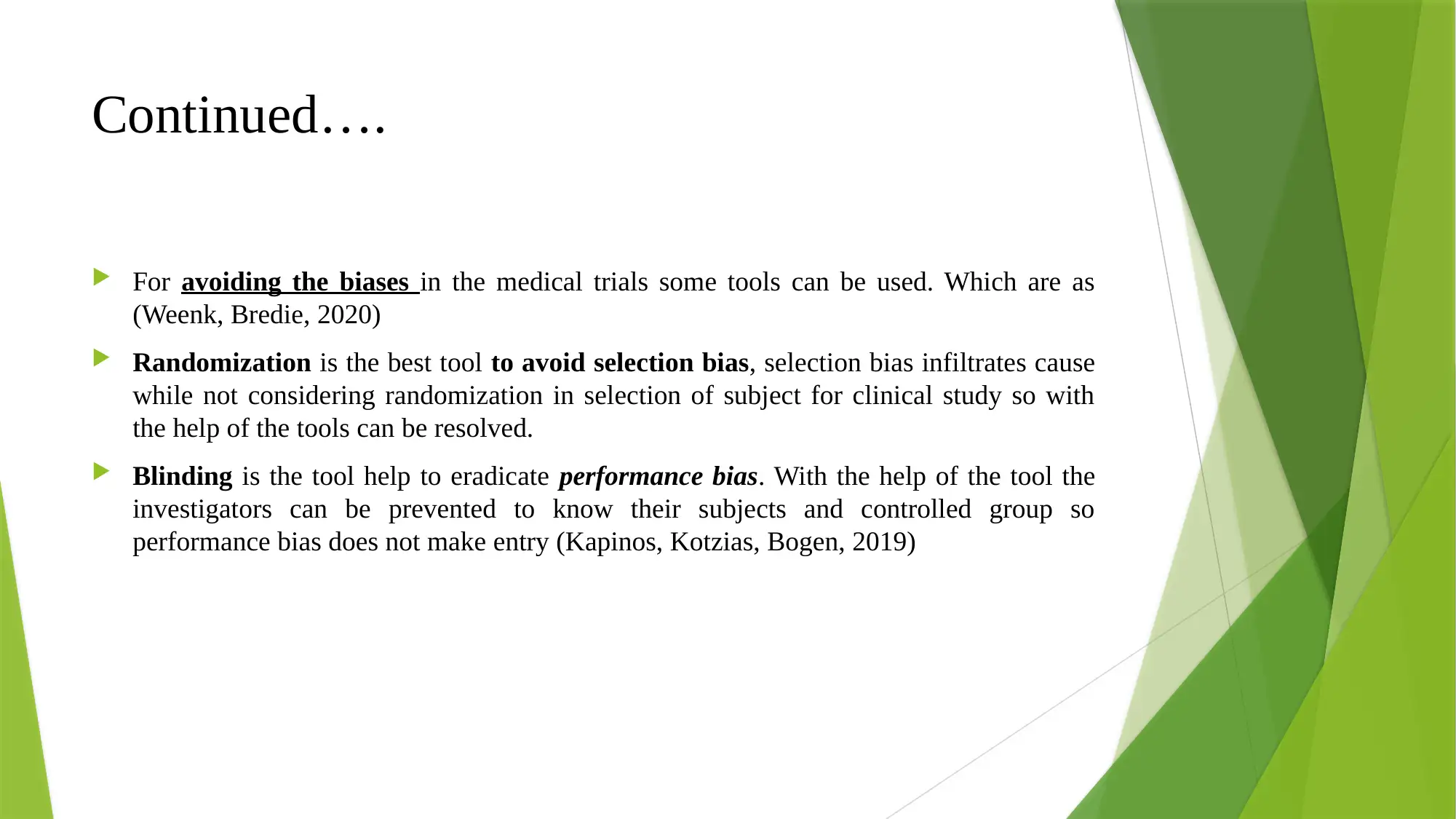
Continued….
For avoiding the biases in the medical trials some tools can be used. Which are as
(Weenk, Bredie, 2020)
Randomization is the best tool to avoid selection bias, selection bias infiltrates cause
while not considering randomization in selection of subject for clinical study so with
the help of the tools can be resolved.
Blinding is the tool help to eradicate performance bias. With the help of the tool the
investigators can be prevented to know their subjects and controlled group so
performance bias does not make entry (Kapinos, Kotzias, Bogen, 2019)
For avoiding the biases in the medical trials some tools can be used. Which are as
(Weenk, Bredie, 2020)
Randomization is the best tool to avoid selection bias, selection bias infiltrates cause
while not considering randomization in selection of subject for clinical study so with
the help of the tools can be resolved.
Blinding is the tool help to eradicate performance bias. With the help of the tool the
investigators can be prevented to know their subjects and controlled group so
performance bias does not make entry (Kapinos, Kotzias, Bogen, 2019)
⊘ This is a preview!⊘
Do you want full access?
Subscribe today to unlock all pages.

Trusted by 1+ million students worldwide
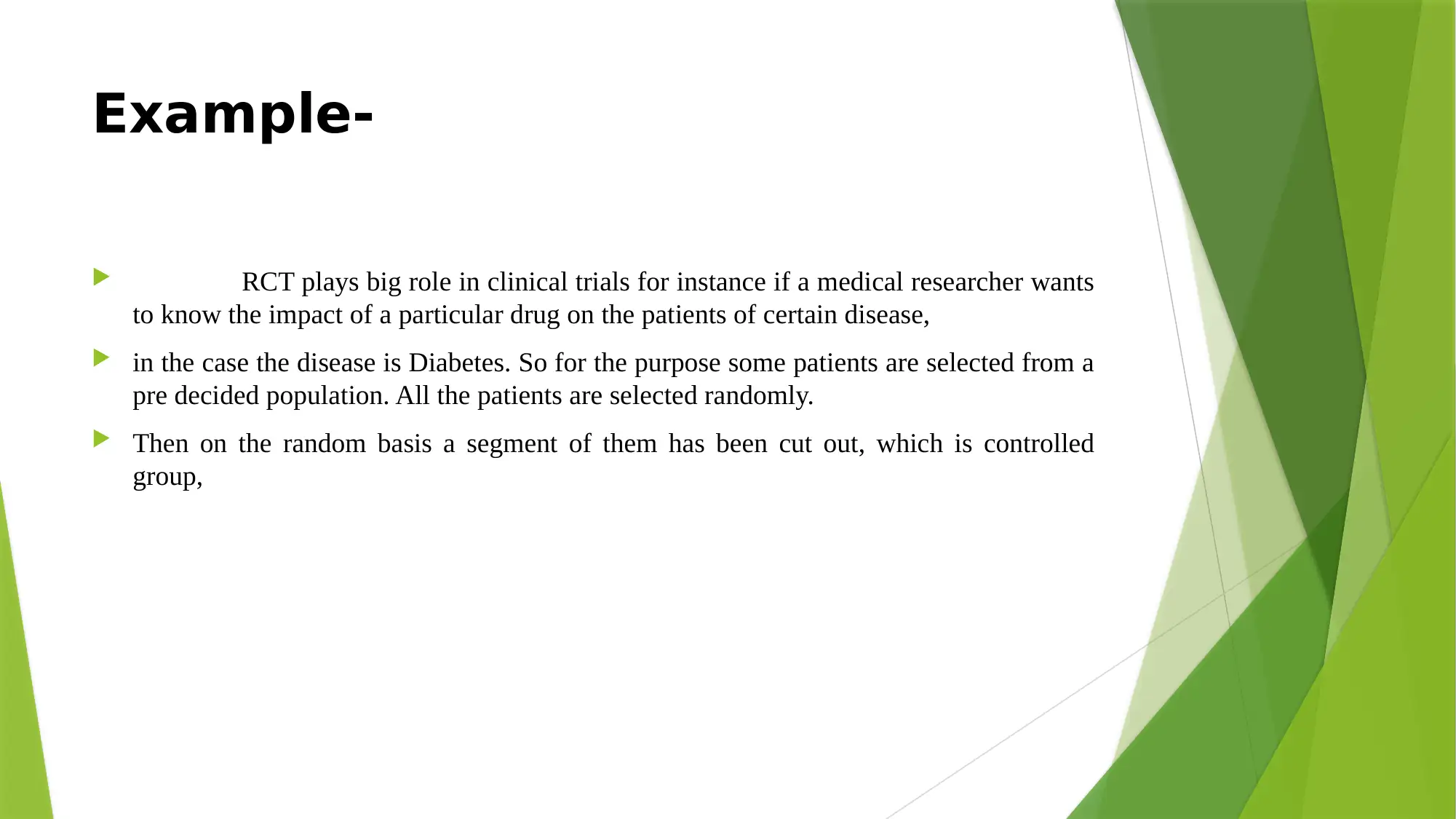
Example-
RCT plays big role in clinical trials for instance if a medical researcher wants
to know the impact of a particular drug on the patients of certain disease,
in the case the disease is Diabetes. So for the purpose some patients are selected from a
pre decided population. All the patients are selected randomly.
Then on the random basis a segment of them has been cut out, which is controlled
group,
RCT plays big role in clinical trials for instance if a medical researcher wants
to know the impact of a particular drug on the patients of certain disease,
in the case the disease is Diabetes. So for the purpose some patients are selected from a
pre decided population. All the patients are selected randomly.
Then on the random basis a segment of them has been cut out, which is controlled
group,
Paraphrase This Document
Need a fresh take? Get an instant paraphrase of this document with our AI Paraphraser

Evaluation and conclusion-
From the study above it can be concluded that the role of RCT is very
prominent in medical trials. Often medical trials are supposed to be executed with
higher level of efficiency and with low bias.
With this regard RCT aids better and eradicate all potential bias. The essay also
discussed all those potential bias which may get arisen even practising RCT
From the study above it can be concluded that the role of RCT is very
prominent in medical trials. Often medical trials are supposed to be executed with
higher level of efficiency and with low bias.
With this regard RCT aids better and eradicate all potential bias. The essay also
discussed all those potential bias which may get arisen even practising RCT
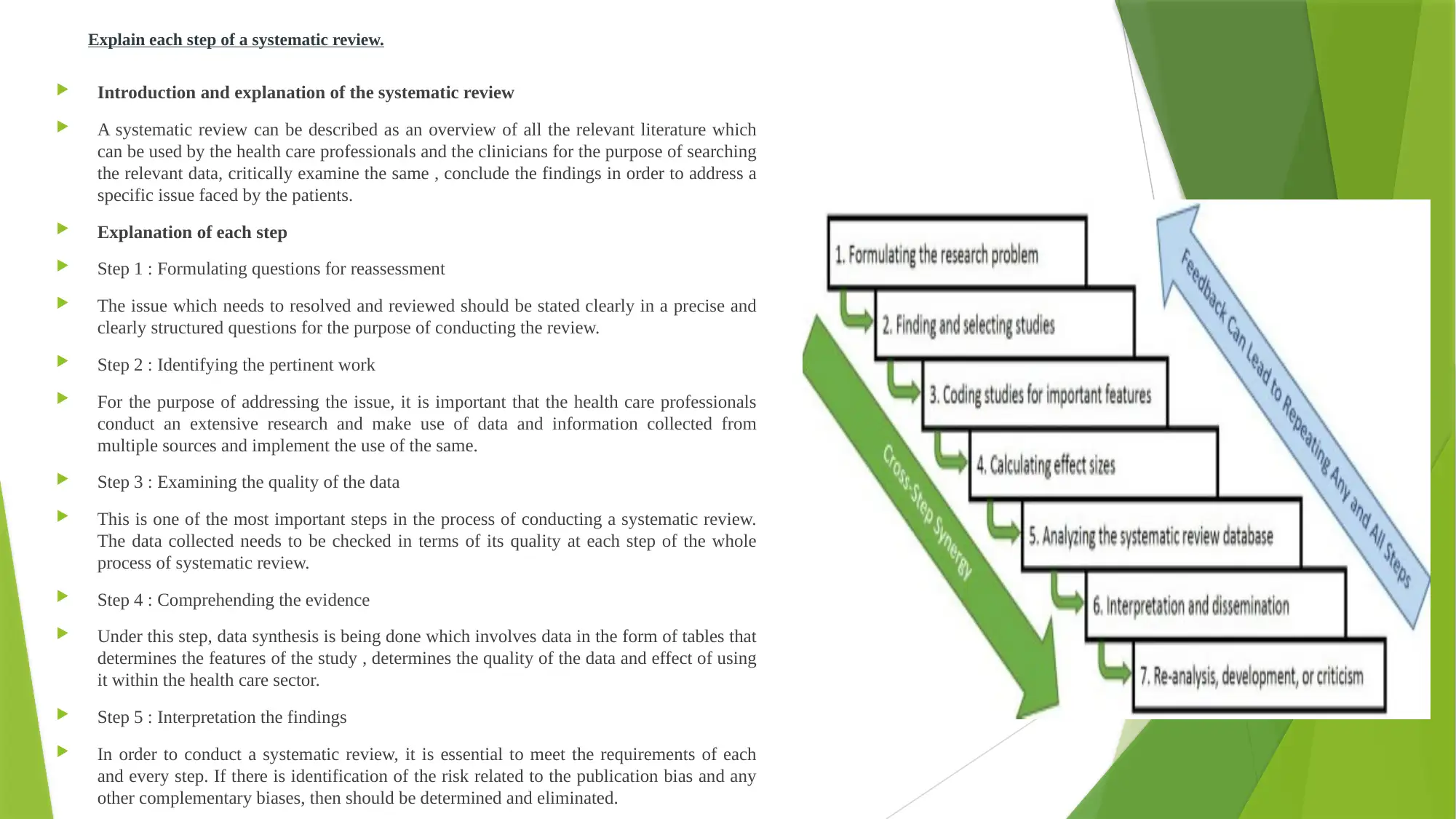
Explain each step of a systematic review.
Introduction and explanation of the systematic review
A systematic review can be described as an overview of all the relevant literature which
can be used by the health care professionals and the clinicians for the purpose of searching
the relevant data, critically examine the same , conclude the findings in order to address a
specific issue faced by the patients.
Explanation of each step
Step 1 : Formulating questions for reassessment
The issue which needs to resolved and reviewed should be stated clearly in a precise and
clearly structured questions for the purpose of conducting the review.
Step 2 : Identifying the pertinent work
For the purpose of addressing the issue, it is important that the health care professionals
conduct an extensive research and make use of data and information collected from
multiple sources and implement the use of the same.
Step 3 : Examining the quality of the data
This is one of the most important steps in the process of conducting a systematic review.
The data collected needs to be checked in terms of its quality at each step of the whole
process of systematic review.
Step 4 : Comprehending the evidence
Under this step, data synthesis is being done which involves data in the form of tables that
determines the features of the study , determines the quality of the data and effect of using
it within the health care sector.
Step 5 : Interpretation the findings
In order to conduct a systematic review, it is essential to meet the requirements of each
and every step. If there is identification of the risk related to the publication bias and any
other complementary biases, then should be determined and eliminated.
Introduction and explanation of the systematic review
A systematic review can be described as an overview of all the relevant literature which
can be used by the health care professionals and the clinicians for the purpose of searching
the relevant data, critically examine the same , conclude the findings in order to address a
specific issue faced by the patients.
Explanation of each step
Step 1 : Formulating questions for reassessment
The issue which needs to resolved and reviewed should be stated clearly in a precise and
clearly structured questions for the purpose of conducting the review.
Step 2 : Identifying the pertinent work
For the purpose of addressing the issue, it is important that the health care professionals
conduct an extensive research and make use of data and information collected from
multiple sources and implement the use of the same.
Step 3 : Examining the quality of the data
This is one of the most important steps in the process of conducting a systematic review.
The data collected needs to be checked in terms of its quality at each step of the whole
process of systematic review.
Step 4 : Comprehending the evidence
Under this step, data synthesis is being done which involves data in the form of tables that
determines the features of the study , determines the quality of the data and effect of using
it within the health care sector.
Step 5 : Interpretation the findings
In order to conduct a systematic review, it is essential to meet the requirements of each
and every step. If there is identification of the risk related to the publication bias and any
other complementary biases, then should be determined and eliminated.
⊘ This is a preview!⊘
Do you want full access?
Subscribe today to unlock all pages.

Trusted by 1+ million students worldwide
1 out of 22
Related Documents
Your All-in-One AI-Powered Toolkit for Academic Success.
+13062052269
info@desklib.com
Available 24*7 on WhatsApp / Email
![[object Object]](/_next/static/media/star-bottom.7253800d.svg)
Unlock your academic potential
Copyright © 2020–2025 A2Z Services. All Rights Reserved. Developed and managed by ZUCOL.





